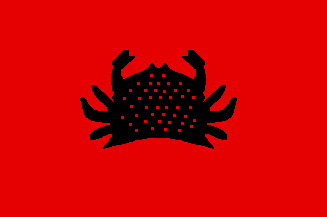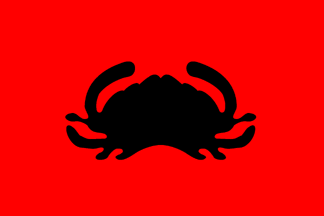 Image by
Jaume Ollé, 02 March 1997
Image by
Jaume Ollé, 02 March 1997

Last modified: 2022-10-22 by bruce berry
Keywords: cameroon | upc | crab (black) | shrimp |
Links: FOTW homepage |
search |
disclaimer and copyright |
write us |
mirrors
 Image by
Antonio Martins, 28 June 2008
Image by
Antonio Martins, 28 June 2008
See also:
The Union des Populations du Cameroun
(UPC) is a political party in Cameroon and was founded in Ndokoti, a suburb of Douala, on 10 April
1948. It was authorized by the French colonial authorities on 09 June
1948. The original aim of the UPC was the independence and reunification
of the two (British and French) Cameroons. The charismatic leader of
the UPC, Ruben Um Nyobé (1913-1958), defended three times the cause of
Cameroon in the United Nations in New York.
On 22 April 1955 the UPC published the "Procalmation commune",
which was considered as an unilateral declaration of independence and a
provocation by the French authorities. On 19 May, Um Nyobé went
underground and on 22 May, the French gendarmes dispersed UPC meetings
and the party announced it would no longer recognize French
authority. Following violent riots, the UPC and its branches were
banned by the French authorities on 13 July 1955. Since the UPC was
the then the main political party in Cameroon, the French authorities
decided to support other, less provocative parties.
In December 1956, the UPC which was banned from participating in the general elections, set up
an armed branch called the "Comité National d'Organisation" (Organization
National Committe or CNO) and started an armed struggle. A
pacification campaign was performed by the French army which
culminated with the assassination of Um Nyobé on 13 September 1958. The independence of Cameroon, under complete French control, was
proclaimed on 01 January 1960 and some leaders of the "legal UPC"
rallied to President Ahidjo. However, others in the UPC continued with the struggle
within the country and abroad. Félix Moumié was poisoned with thallium on 3
November 1960 in Geneva by a French secret agent. A post-colonial struggle by
UPC rebels
opposing the new Cameroon army (trained and armed by France) continued until August 1970 when the last
battalion of the UPC, commanded by Ernest Ouandié, was arrested. Ouandié
was sentenced to death and was shot on 15 January 1971. The civil war,
resulting in the destruction of villages and use of napalm is estimated to have
resulted in between
30,000 and 500,000 deaths. It has been conveniently removed from official
history, both in Cameroon and in France.
The end of the war did not mean the end of the repression, since multi-partyism was not authorized in Cameroon
until 1991. The UPC
entered the Parliament and the Government in 1992 but lost all its
seats in the general elections of 2007.
Sources:
- "Cameroun, autopsie d'une indépendance", TV documentary (France 5), 23 June 2008, Presentation in French
- "Ruben Um Nyobé, secrétaire général de l'Union des Populations du Cameroun (1913-1958)" by Paul Yange, www.grioo.com
- Enoh Meyomesse, "Camer.be", 15 April 2008, UPC website in French
- CV Dr Mack Kit.pdf in French
Ivan Sache, 28 June 2008
 Image by
Jaume Ollé, 02 March 1997
Image by
Jaume Ollé, 02 March 1997
The flag of the UPC was adopted on 22 May 1955 in Yaoundé by
Félix Moumié. It is a red flag with a black crab in the centre. The few available
reports of the party flag mention a crab and not a shrimp, as claimed
by Whitney Smith. There are nearly no archive images from that period, since
the French Army keep everything classified.
The red flag with the crab is shown, as a graphic, on the official
documents of the party today.
Ivan Sache, 28 June 2008
Just for the record: Cameroon/Camerun, as in the country name and also in the mountain of the same name after which the country was named, comes from the Portuguese word "Camarões" (which is also the current
Portuguese name for the country). However, this does not mean "crabs", as often reported, but "shrimps". And I'm quite sure that this was also so by the time this name was given to that mountain, back in the 16th century.
Antonio Martins-Tuvalkin, 5 March 1999
Whitney Smith (1976) [smi76a] explains that the name of the country comes from the
Portuguese camaroes (shrimps), because Portuguese explorers found
shrimps in a river there. Smith adds that the flag proposed by the
anti-colonialist organization (I guess it was UPC) was a red field
bearing a shrimp, and not a crab.
Ivan Sache, 13 February 2001
In 'DTV-Lexikon politischer Symbole' (1970) Arnold Rabbow [rab70] writes:
Originally it should have been canting with the name of the country symbolized on it by way of the crab (Krabbe) after the Portuguese word 'camarão', from which the name of Cameroon was derived. Western observers remarked that the crab might evoke world-ridicule, after which the model of the tricolore, after the French example, was chosen.
Whether crab or shrimp - I think that Rabbow has a point there.
Jarig Bakker, 13 Feb 2000
The new
independent state of Cameroon would not have adopted the crab flag
because of its ridiculous design, but because it was already the flag of an
armed movement that refused the independence. It was much more logical
to adopt a flag derived from the the flag of the French benefactor.
Ivan Sache, 28 June 2008
Interesting that Smith says so: Even if it is correct, most non-Portuguese
sources (not only vexillological books, but also encyclopedias etc.)
usually incorrectly say that "camarões" means "crabs" instead of "shrimps".
The name was given firstly to a coastal river, then to a nearby high
mountain, currently Cameroon Mt. When the German colony was created in the
current boundaries (more or less), the territory was given the name Cameroon
Antonio Martins, 15 Feb 2000
This design, by the way, is not really zoologically correct. However, there is an uncanny
similarity with the 19th century naval flag of Courland, Latvia.
Antonio Martins, 28 June 2008